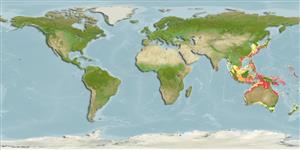Common names from other countries
Environment: milieu / climate zone / depth range / distribution range
экология
морской демерсальный; пределы глубины 13 - 78 m (Ref. 9494), usually 15 - 25 m (Ref. 9774). Tropical
Indo-West Pacific: Indo-Australian Archipelago.
Size / Вес / Возраст
Maturity: Lm ? range ? - ? cm
Max length : 25.0 cm SL самец/пол неопределен; (Ref. 9774); common length : 17.5 cm SL самец/пол неопределен; (Ref. 9774)
колючие лучи спинного плавника (общее число) : 0; членистые (мягкие) лучи спинного плавника (общее число) : 67 - 72; колючие лучи анального плавника: 0; членистые (мягкие) лучи анального плавника: 51 - 55. Body brownish, 2 double or tripe ocelli above and below lateral line and 1 on posterior third of straight section of lateral line. Many dark spots and rings scattered on body and median fins. Pectoral fin on ocular side with 12-13 rays. Pelvic fins short based, subequal and sub symmetrical in position, posterior 3-4 rays branched.
Inhabits muddy and sandy bottoms (Ref. 9774). Feeds on small benthic animals (Ref. 9774). Caught mainly with bottom prawn trawls (Ref. 9774).
Life cycle and mating behavior
Maturities | размножение | Spawnings | Egg(s) | Fecundities | личинки
Distinct pairing (Ref. 205).
Kailola, P.J., 1991. The fishes of Papua New Guinea: a revised and annotated checklist. Vol. III. Gobiidae to Molidae. Research Bulletin No. 41, Research Section, Dept. of Fisheries and Marine Resources, Papua New Guinea. 153 p. (Ref. 6771)
Статус Красного Списка МСОП (Ref. 130435)
CITES (Ref. 128078)
Not Evaluated
Угроза для людей
Harmless
Использование человеком
дополнительная информация
инструменты
Специальные отчеты
Скачать в формате XML
ресурсы в Интернет
Estimates based on models
Preferred temperature (Ref.
115969): 24.5 - 29, mean 28 (based on 310 cells).
Phylogenetic diversity index (Ref.
82804): PD
50 = 0.5000 [Uniqueness, from 0.5 = low to 2.0 = high].
Bayesian length-weight: a=0.00741 (0.00343 - 0.01604), b=3.17 (3.00 - 3.34), in cm Total Length, based on LWR estimates for this Genus-body shape (Ref.
93245).
Trophic level (Ref.
69278): 3.5 ±0.37 se; based on food items.
устойчивость к внешним воздействиям (Ref.
120179): высокий, минимальное время удвоения популяции до 15 месяцев (Preliminary K or Fecundity.).
Fishing Vulnerability (Ref.
59153): Low vulnerability (21 of 100).
